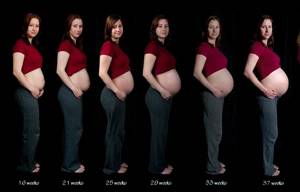At what stage of pregnancy is the belly visible?
There is no exact definition that you can use to determine exactly when a belly bump will be noticeable. This usually occurs in the 12th week of pregnancy. But, there are cases when the tummy is visible only at the end of the second trimester, that is, at the turn of the 6th and 7th month. At this moment, the most intensive growth of the abdominal cavity occurs, as the child begins to grow rapidly, rounding the mother’s belly.
When asked what week the belly will be noticeable. - The answer will not be 100% accurate: but, it usually happens between 12 and 18 weeks. Everything is individual!
Factors that may affect belly growth:
1. Body weight
If you're a skinny mom, you'll likely see your belly much sooner than smaller or overweight women. Usually, at the 10th week of pregnancy, you may already see the first rounding of the abdomen. The uterus begins to grow to accommodate the developing fetus, so a thin woman's belly will be visible earlier than that of a fuller person.
2. Activity and body structure
In the case of less athletic women, the belly will be noticeable earlier than in people with stronger and more trained abdominal muscles, which will resist stretching longer.
3. Height
In short women with a relatively short torso, the belly is released faster, so pregnancy will be noticeable earlier than in others.
When does a pregnant belly start to grow?
There are average figures that show the growth of the abdomen during pregnancy. It is these that doctors focus on when conducting an external obstetric examination.
According to the rules, measurements begin to be taken from a strictly defined time, when the fundus of the uterus appears above the pubic fusion and the first signs of roundness appear. As a rule, in most pregnant women such changes occur at four months.
However, in practice, not all expectant mothers fit into the dry statistics. Sometimes the belly grows much earlier or later than the specified time. Therefore, there is no need to panic because of a slight discrepancy in the timing and listen to the stories of pregnant friends. Moreover, many do not see the difference between the enlargement of the uterus and the growth of the abdomen, which is sometimes completely unrelated to the interesting position.
What size belly should be during pregnancy?
It makes no sense to compare belly sizes with others! Because every body functions differently and children develop at their own pace. A big belly does not always mean that a woman will give birth to a large baby. Besides the baby itself, there are other elements in the belly that make the belly much larger than usual. Including the placenta or amniotic fluid. Although the belly should grow from week to week, remember that a small belly does not have to be associated with abnormalities!
There are folk beliefs that the shape and size of the abdomen should indicate the sex of the child. This is certainly interesting! But, these claims have not been scientifically proven.
What determines the rate of abdominal growth during pregnancy?
The dynamics of waist rounding can be used to assess the course of gestation. If there are deviations from the norm, doctors prescribe examinations to patients to identify the cause. The rate of belly enlargement is affected by:
- Fetal growth. Every day the growth and weight of the embryo increases. By the time of birth, the weight of the fetus reaches 5 kg.
- Rate of uterine development. It increases throughout the entire gestation stage. Before conception, the weight of the organ reaches 100 grams, and by the period of childbirth it increases to 1 kg. During pregnancy, the uterine cavity increases up to 500 times.
- Woman's weight. Changes in the taste preferences of pregnant women affect body weight. Some women rapidly gain weight, while others, on the contrary, begin to lose it. In thin women, the belly is visible earlier, and this is not related to the growth rate of the reproductive organ. In overweight people, on the contrary, the roundness of the waist will appear only by the 5th month.
- The amount of amniotic fluid. Their volume is regularly increasing. At the initial stage it is 30 ml, by the 37th week – 1-1.5 liters, by childbirth it decreases to 400-800 grams. Insufficient or excessive amount of amniotic fluid leads to abnormal development of the embryo.
- Anatomical structure. Muscle contractility and the patient’s weight are of great importance. Low body weight and elasticity of muscle tissue can hide pregnancy from others for a long time.
- Hereditary factor. If the patient’s close relatives (mother, grandmother) have a belly that begins to grow late when carrying a child, most likely this will happen to the woman herself.
- Presentation of the ovum. If it is attached to the front wall of the reproductive organ, the roundness will be much greater than if it is located closer to the spine.

At what week does the belly begin to grow in obese women?
With excess weight, patients notice the growth of the abdomen during pregnancy much later than the standard period. Only from the 5th month can others see external changes. A huge amount of fatty tissue carefully hides the situation.
When the belly becomes noticeable in thin people
In thin women, pregnancy is noticed as early as 4 months due to the small amount of fatty tissue. This period marks the rapid growth of the embryo and uterus. As they increase, there is an increase in waist circumference.
Is it possible to pump up abs during pregnancy?
During pregnancy, physical activity is recommended, but any exercise to strengthen the abdominal structure is prohibited! If you did abdominal exercises before pregnancy, you will have to give them up. You can return to abdominal exercises only after the end of the postpartum period, when your body is ready for intense exercise. But you can practice with other types if there are no contraindications. For example, classes dedicated to pregnant women - yoga, aerobics. But remember that it is better to consult a doctor and be sure that discipline will not pose a threat to the child.
As your baby grows, you may experience problems such as constipation or shortness of breath. Because a developing baby puts pressure on your organs. You will feel relief only 2-3 weeks before giving birth, when your stomach drops. This is due to the lowering of the baby as it prepares to be born. To solve the problem, try to provide yourself with the right diet. Rich in fiber, which will reduce the risk of constipation and heartburn.
Remember that during pregnancy you should not eat for two, only for two, so choose foods that will be healthy for both you and your baby. Also, try not to gain too much weight during pregnancy and not to exceed the nutritional standards recommended by experts.
Factors affecting belly growth

Photo from kadinmi.com
The growth of the belly is affected by many factors, which the expectant mother sometimes does not even suspect. And often this ignorance becomes the cause of unnecessary worries and speculation.
The following points affect the girth of a pregnant woman’s abdomen:
- amount of amniotic fluid;
- heredity;
- placenta attachment site;
- general weight gain;
- structural features;
- fruit size.
Nutrition has a very big influence on the growth of the expectant mother’s belly. While carrying a baby, your appetite increases, and the bulk of fat cells are deposited in the abdominal area - this is how nature intended it to protect the baby from various injuries.
Therefore, if a pregnant woman eats a lot and quickly gains weight, her abdominal girth increases at the same rate, significantly exceeding generally accepted norms. Active gain in kilograms and centimeters is very harmful for mother and baby. The condition is dangerous due to the development of late toxicosis, early labor, premature separation of the placenta, back pain, swelling of the limbs and severe fatigue.
And of course, you should not go on a diet during pregnancy, trying to reduce your growing belly. This will not lead to anything good. Fasting is just as dangerous for the expectant mother and fetus as overeating.
When is the belly hard to see during pregnancy if the girl is not large? As a rule, various pathologies become the cause of deterioration in performance. For example, intrauterine infection, frozen pregnancy in the first months, severe toxicosis, retarded fetal height and weight, oligohydramnios.
The reason for a significant increase in abdominal circumference may be a placenta that is too thick, obesity, incorrect (transverse) placement of the fetus, or excess amniotic fluid. Naturally, multiple births and a narrow pelvis affect the growth of the abdomen.
How do doctors record the growth of the belly of pregnant women?
Determination of abdominal circumference begins at 12–13 weeks of pregnancy. This allows you to fully monitor the dynamics of fetal growth and development, and most importantly, to identify factors that can negatively affect the course of labor.
Only a specialist can assess abdominal growth, guided by the following rules:
- During manipulations, the woman should lie on a hard couch without arching in the lower back. You need to completely relax, “let go of your stomach” and stretch your legs.
- For measurements, use one centimeter tape. This is a common tailor's tape that every doctor has.
- Before manipulation, you must empty your bladder. This will eliminate data distortion and help determine how correctly the belly grows during pregnancy.
The doctor checks the obtained indicators with a special table, which is in each office.
Abdominal circumference chart.
| Gestational age | Normal indicators |
| 20 weeks | 70–75 cm |
| 24 weeks | 76–80 cm |
| 26 weeks | 78–82 cm |
| 30 weeks | 83–87 cm |
| 34 weeks | 88–92 cm |
| 38 weeks | 93–98 cm |
| 40 weeks | 96–102 cm |
When measuring the abdominal circumference, the measuring tape is placed strictly along the navel line, without tightening or relaxing it. The procedure helps not only to assess the development and growth of the fetus, but also to clarify the number of weeks of pregnancy.
In order not to worry in vain during the crucial period of waiting for the baby and not to be tormented by the question of when the belly will begin to grow, you need to regularly visit your gynecologist and follow the doctor’s instructions. Then, no matter what your waist circumference, the entire pregnancy will go smoothly and end with a successful birth.
Author: Elena Medvedeva, doctor, especially for Mama66.ru
Useful video about when the belly begins to grow during pregnancy
List of sources:
- Workshop on obstetrics / V. S. Orlova, P. A. Karpov, I. V. Budnik // Belgorod: BelSU, 2010.
- Obstetrics. Physiology of pregnancy / Gumenyuk E. G. // Petrozavodsk: IntelTek, 2004.
- Obstetrics: a textbook for students of institutions providing higher education in the specialty “General Medicine” / V. I. Duda, Vl. I. Duda, I. V. Duda. - 2nd ed., //Minsk, 2007.
Author
Elena Medvedeva
Specialist
Graduated from the Ural State Medical Academy of Yekaterinburg with a degree in General Medicine. Work experience: intensive care team, physician at an enterprise. All articles by the author
I like!









